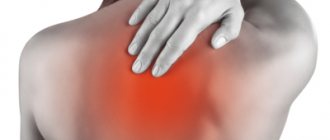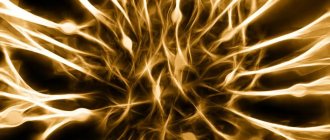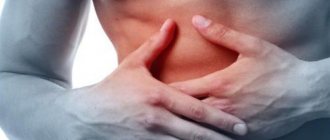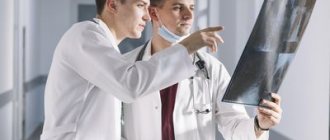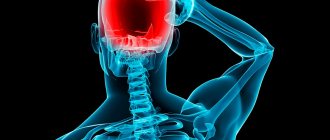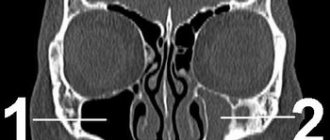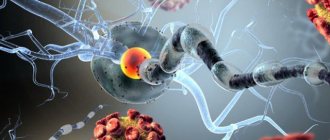In our Center we can offer comprehensive treatment of intercostal neuralgia using the Multigen radiofrequency ablation device. We will answer all your questions by phone. You can also ask a question by filling out the request form below.
Intercostal neuralgia , or thoracalgia , is pain that is felt along the passage of the nerve and is localized in the intercostal space. It may also be accompanied by other uncomfortable sensations - numbness, burning.
general information
There are 12 pairs of intercostal nerves in the human body. They originate from the roots of the thoracic spinal cord and cover the entire chest, adjacent to the peritoneum, muscles, skin and mammary glands. The individual fibers of each nerve are responsible for tissue sensitivity, motor function and regulation of the functioning of all structures. Accordingly, damage or inflammation in any area can radiate pain to a variety of parts of the body.
The sensations can imitate diseases of internal organs: myocardial infarction, angina pectoris, pancreatitis, gastritis, cholecystitis, etc. In some cases, only a doctor can accurately determine the nature of the pain after a full examination. That is why it is important to seek help promptly if chest pain occurs.
Make an appointment
Indications
It is recommended to use Finalgon to improve blood circulation, eliminate pain in muscles and joints, and in the complex treatment of damage and inflammation of the musculoskeletal system. Its scope of use includes:
- rheumatic processes;
- arthralgia;
- myalgia;
- consequences of ligamentous injuries;
- neuralgic manifestations;
- sciatica, lumbago;
- symptoms of osteochondrosis;
- sports overload of muscles and joints.
Finalgon helps prevent exacerbation of chronic inflammatory diseases after prolonged exercise or hypothermia. It restores peripheral blood circulation in vegetative vascular pathologies. Athletes sometimes use it to warm up and improve blood flow to muscles before long workouts. According to reviews, Finalgon cream promotes the resorption of cellulite in the subcutaneous tissue if used in combination with special massage procedures. The irritating effect of the components has the same mechanism as most cosmetic anti-cellulite products.
Forms
There is no special classification of the disease. There are several separate forms depending on the mechanism of occurrence:
- radicular: associated with irritation of the spinal cord roots at the point of their exit from the spinal column;
- reflex: associated with overstrain of muscle fibers at the site of the nerve passage.
There is also a classification of neuralgia depending on:
- causes: primary (associated with damage or inflammation of the nerve itself) and secondary (due to other diseases);
- localization: unilateral and bilateral;
- course of the disease: acute and chronic.
Causes
The list of main causes of intercostal neuralgia includes:
- degenerative-dystrophic diseases of the spine: osteochondrosis, arthrosis, hernias and protrusions of discs, etc.;
- uneven or excessive load on the spine and back muscles (due to carrying heavy objects, poor posture, etc.);
- spinal column deformities (primarily scoliosis);
- diseases of the nervous system, in particular multiple sclerosis;
- infectious lesions: tuberculosis, herpes zoster, influenza;
- injuries of the spine and chest, surgical interventions in this area;
- tumors in the ribs, sternum, spinal column;
- taking certain medications;
- increased load on the respiratory muscles and abdominal muscles;
- increased intra-abdominal pressure, including during pregnancy.
In addition, intercostal neuralgia can occur secondary to other diseases, for example, pleurisy, pathology of the digestive system, kidney disease, thyrotoxicosis, and immunodeficiency states. Adolescents during the period of active skeletal growth may also experience similar symptoms.
Symptoms
The main symptom of intercostal neuralgia is severe pain in the chest along the nerve. As a rule, it occurs suddenly and resembles an electric shock, gradually spreading along the ribs. The nature of the sensations can be different: shooting, pulsating, constant, burning or dull.
Deep breathing, turning the head or body, bending, pressing or simply touching the chest causes a pronounced increase in pain. In addition, characteristic signs of neuralgia are:
- persistence of pain at night;
- the ability to determine the epicenter of pain;
- redness or paleness of the skin in the affected area;
- a feeling of tingling, crawling or, conversely, numbness along the affected nerve;
- slight muscle twitching in the affected area.
As a rule, during an attack of neuralgia, a person tries to lie or sit motionless in a position in which the pain becomes slightly less.
If the cause of the pain syndrome is herpes zoster, first redness appears on the skin along the affected nerve, then numerous blisters that burst, forming crusts. After recovery, increased pigmentation remains in this area for some time.
Differences from myocardial infarction
Chest pain, especially on the left, can be a consequence not only of intercostal neuralgia, but also of more serious problems. The most dangerous is myocardial infarction. This condition requires emergency medical attention. The characteristic differences in pain are:
- occurrence against the background of physical, less often psycho-emotional stress;
- spread to the left arm, shoulder, left half of the neck and lower jaw;
- no changes when turning the body, bending, pressing on the sore area;
- decreased intensity when taking nitroglycerin and its analogues.
A heart attack is often accompanied by cold, sticky sweat, pale skin, dizziness, and fear of death.
It is important to remember that the signs of a cardiovascular accident and intercostal neuralgia are not always so radically different. An accurate diagnosis can only be made by a doctor.
Mechanism of action of Finalgon
Nonivamide in the composition of the drug, upon contact with the skin, irritates superficial nerve endings and dilates the vessels of the capillary network. Thanks to this, blood flow to the affected area increases, microcirculation is stimulated, and swelling resolves faster. The burning and tingling sensation caused by capsaicin leads to a reduction in pain, spasms, helps restore the mobility of damaged structures, and is distracting in case of severe pain.
Nicoboxil, which is contained in cream and ointment several times more than nonivamide, has a more pronounced vasodilating and warming effect. Its contact with the skin causes a sensation of intense heat, similar to the effect of mustard plasters. Both active substances act on pain prostaglandins, reducing the symptoms of muscle and joint diseases.
The effect of the medicine begins 3-5 minutes after applying it to the skin. The therapeutic effect increases within half an hour and lasts for about 2–4 hours. A feeling of warmth, redness and tingling of the skin develops locally: only in places where the drug comes into contact with the body, without spreading throughout the body.
With repeated applications of Finalgon, the analgesic effect of the drug increases and lasts longer than with the first use, since the sensitivity of the nerve endings to it increases.
Diagnostics
Intercostal neuralgia, regardless of the severity of the pain syndrome and its location, requires a full diagnosis. The following examinations will help distinguish it from other pathologies:
- questioning and medical history: identifying the nature of the sensations, the conditions of their occurrence, the duration of the attack, concomitant diseases;
- examination and palpation: the doctor evaluates the appearance of the skin, checks the reaction to movements, pressing, turning, bending, assesses the severity of reflexes;
- laboratory diagnostics: general and biochemical blood tests, general urine tests: allows to identify signs of damage to the heart muscle (tests for troponins, CPK), inflammation, renal pathology, gastrointestinal diseases, etc.; the exact set of tests depends on the location of the source of pain;
- ECG, ultrasound of the heart: allow you to identify or exclude cardiovascular pathology;
- X-ray, CT or MRI of the thoracic spine: helps to identify osteochondrosis, osteoporosis, tumors, hernias and protrusions of intervertebral discs, etc.;
- Chest x-ray: allows you to assess the condition of the lung tissue and identify signs of tumors;
- Ultrasound of the kidneys, abdominal organs (excludes relevant pathology);
- FGDS to exclude pathologies of the esophagus, stomach, duodenum;
- myelography, contrast discography, electrospondylography to assess the condition of the spine, intervertebral discs, spinal cord and its roots.
If necessary, consultations with narrow specialists and additional examinations are prescribed.
Make an appointment
How to use Finalgon
The drug is applied to clean skin, rubbing thoroughly. For moderate pain, it is recommended to choose a cream. For sharp, unbearable pain, it is more useful to use ointment.
- Squeeze a small amount of the drug onto the palm of your hand, applicator or cotton pad;
- distribute the product over the skin and quickly rub until absorbed, avoiding touching other parts of the body and face;
- if necessary, the application site can be covered with a warm cloth;
- After using Finalgon, hands should be washed thoroughly with detergent;
- the procedure must be repeated 2-3 times a day; it is useful to use the drug at night.
After using Finalgon on open areas of the body, it is not advisable to go out into the bright sun to avoid burns. You should not take water procedures within 2 hours, as otherwise the active substances will be washed off from the skin.
Treatment
Intercostal neuralgia requires complex and often long-term treatment, including medication, physiotherapy, massage, etc.
Drug therapy
In the acute phase of the disease, therapy is aimed at relieving pain and improving the patient's condition. Depending on the specific clinical situation, the following are prescribed:
- non-steroidal anti-inflammatory drugs (NSAIDs): products based on diclofenac, nimesulide, ibuprofen, meloxicam and their derivatives; used in tablet, injection and local (creams, ointments, patches) form;
- analgesics: analgin and products based on it; like NSAIDs, they relieve pain;
- muscle relaxants to eliminate muscle spasms: mydocalm, etc.;
- group vitamins: milgamma, neuromultivitis, etc.; necessary to restore normal functioning of nerve fibers;
- sedatives to reduce the psycho-emotional component of pain and improve sleep.
If necessary, the following may additionally be prescribed:
- anticonvulsants: inhibit the passage of pain impulses;
- antidepressants to relieve tension;
- antihistamines and diuretics: relieve tissue swelling, especially relevant for pinched nerve roots;
- antiviral drugs for herpes zoster;
- glucocorticosteroids for persistent pain and severe inflammation that cannot be relieved by milder means.
Physiotherapy and exercise therapy
Physiotherapeutic procedures are prescribed after the acute pain subsides. Help speed up recovery:
- UHF;
- reflexology;
- magnetic therapy;
- electrophoresis;
- laser treatment;
- paraffin applications;
- mud therapy.
These procedures help improve blood circulation and metabolism in the affected area and accelerate the regeneration of nerve tissue.
Physical therapy exercises are prescribed after complete recovery. The main goal of gymnastics is to unload the back muscles. The complex is developed individually. The first classes should be carried out under the supervision of a specialist; in the future, home exercises are allowed.
Other treatments
Since very often the cause of intercostal neuralgia is pathology of the spine and spinal cord, the following are often used as additional methods of influence:
- acupuncture;
- manual therapy;
- therapeutic massage, including the use of warming agents;
- Shiatsu massage (acupressure);
- osteopathy;
- underwater traction and other techniques.
Like all medical procedures, these techniques are used only in a clinical setting and are carried out by specialists with medical education and the appropriate certificate.
Tablets for intercostal neuralgia
Of the medications that alleviate the course of this disease, the first place goes to analgesics (analgin, sedalgin) and non-steroidal drugs (ibuprofen, piroxicam, indomethacin), which have anti-inflammatory properties. They should be taken regularly for pain prevention purposes, without waiting for a new attack to occur.
Drugs that belong to the group of muscle relaxants (tizanidine or baclofen) help not only eliminate pain, but also relieve muscle spasms in the area of injury. Medicines in this group must be used with caution, especially for people driving and associated with work involving a high concentration of attention.
To relieve nervous tension, you can take sedatives. Be sure to carry out vitamin therapy . Complexes containing daily dosages of B .
Intercostal neuralgia with unbearable pain can be successfully relieved with lidocaine or novocaine blockades . These procedures are usually performed in specialized centers. But in particularly severe cases of the disease, the prescription of steroids, usually prednisone, is indicated.
A good effect is achieved when physiotherapeutic methods . They include UV irradiation of the corresponding paravertebral region, electrophoresis with lidocaine, especially in the acute period. When the phase transitions from acute to subacute, darsonvalization, microwave therapy, and phonophoresis are prescribed. Reflexology is widely used for this pathology.
Complications
Complications of intercostal neuralgia occur quite rarely, however, in severe cases, without appropriate treatment, the patient may encounter the following problems:
- severe spasm of the respiratory muscles, limiting inhalation and exhalation;
- inability to get out of bed due to significant increase in pain;
- excessive pain syndrome that is not relieved by conventional analgesics and NSAIDs;
- heart rhythm disturbances due to muscle spasms and nerve pathology;
- decreased leg mobility.
In addition, complications can be caused by attempts to be treated outside the clinic. Abscesses and cellulitis after acupuncture, paralysis and decreased sensitivity after manual therapy are not a complete list of problems. That is why you should not treat intercostal neuralgia either independently or with the help of dubious specialists.
Prevention
Prevention of intercostal neuralgia is mainly general measures aimed at strengthening the muscle frame and improving the health of the body. Neurologists recommend:
- lead an active lifestyle, play sports at an amateur level;
- minimize hypothermia and colds;
- watch your posture;
- avoid lifting heavy objects;
- maintain a high level of immunity;
- eat a balanced diet, if necessary, take additional vitamins, especially group B;
- treat chronic diseases in a timely manner;
- avoid stress, get proper rest and ensure yourself at least 8 hours of sleep every night.
Following these simple rules will significantly reduce the risk of developing intercostal neuralgia.
Treatment at the Energy of Health clinic
Doctors at the Energy of Health clinic will always come to the aid of patients with intercostal neuralgia. We offer each client:
- a full examination with consultations with specialists for an accurate diagnosis;
- individual selection of treatment regimen;
- services of a qualified chiropractor;
- own exercise therapy room for the most effective and safe exercises;
- modern methods of physiotherapy;
- massotherapy;
- drug blockades for severe pain syndrome.
Regular observation by a neurologist after the acute period of the disease has subsided will help prevent recurrent attacks.
How to treat intercostal neuralgia?
Since this symptom develops against the background of a large number of different diseases, the doctor must accurately identify the cause of its occurrence and prescribe adequate treatment.
Intercostal neuralgia sometimes simulates an attack of heart pain, but discomfort appears predominantly in the left half of the chest; moreover, it does not depend on breathing or movement and does not occur with external palpation.
The most advanced diagnostics are now possible using the most modern research methods, such as computed tomography and magnetic resonance imaging. These techniques make it possible to detect neoplasms, signs of changes in the brain and spinal cord, and damage to internal organs with high accuracy.
During the acute period, the patient should strictly observe a rest regime. It is necessary to limit sudden movements, physical activity, and body turns. Sitting should be avoided. You need to lie on a flat and level surface. You can apply sand in bags, pepper patch, or a heating pad, that is, dry heat, to the painful area. To enhance the thermal effect, you can tie yourself with a scarf made of natural wool.
Advantages of the clinic
In the neurology department of the Energy of Health clinic, every patient receives the highest level of specialists and modern equipment for diagnosing and treating diseases. We take an integrated approach to therapy and use not only medications, but also physiotherapy, exercise therapy and massage.
Treatment is prescribed only after a thorough examination and is monitored by a specialist until the patients fully recover. Adequate prices, convenient location, private parking - we do everything for the convenience of our clients.
If intercostal neuralgia interferes with living, walking and moving, do not delay treatment. Sign up for the Health Energy clinic and get rid of pain.

